UnfoldLabs Inc.| Top 7 Tech Developments to Watch in 2017
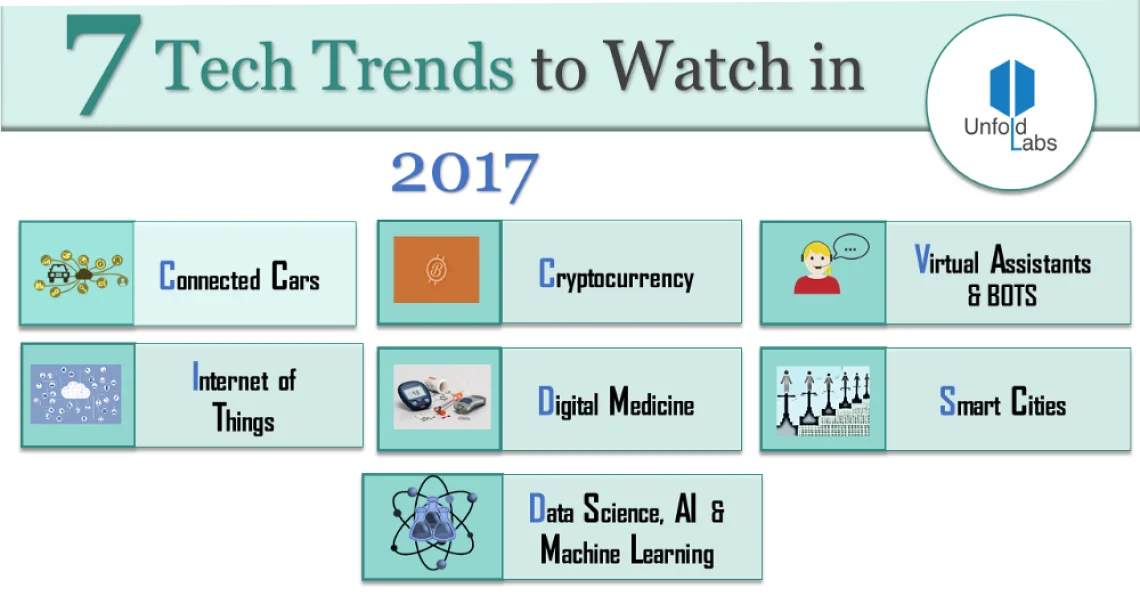
2017 will bring many game changes in the world of technology. Not only will we be seeing innovation from the US, innovation will also come from many techhubs around the world. Last year was certainly a year of growth for tech; however, many more technology breakthroughs and trends will dominate this year.
Numerous tech innovations in various sectors will make an impact in 2017. Many are already being used today; however, these will not only increase, they will be improved upon. A multitude of technologies will assist us in our daily lives, but some are being created to change and improve the world. We've only seen the tip of the iceberg and we're bound to see many more!
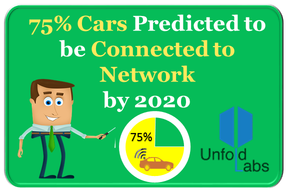
1. Connected Cars
Connected cars are not a new concept anymore. In 1996, General Motors presented the first connected car feature with OnStar. It is predicted by Ernst & Young that 16 million new cars in the United States will feature embedded telematics by 2025 — the same year it is expected that fully automated vehicles will be commercially available. Connected vehicle technologies and applications will also include preventative maintenance and remote diagnostics that allow drivers to receive alerts of hazardous situations much earlier, giving drivers more time to react and prevent accidents. Moreover, aside from the popularity of Google's self-driving cars, 20 other companies, some with the help of Israeli technology, are working on manufacturing autonomous vehicles, including Audi, Toyota, BMW, Volvo and Ford, that is targeting the release of a fully self-driving car in 2021.
BI Intelligence estimates that by 2020, 75% of cars shipped globally will be capable of connecting to the internet. Although the market for connected car packages in 2017 will continue to center on premium vehicles, with an average vehicle selling price of $55,000, it is predicted to drop significantly in the next few years as the technology becomes available to the volume market as well. Research by Strategy Analytics reveals that the global car market has the potential to build value from the sale of connected car packages, car functions offered as bundles either as built-in or subscription-based services, from $52.5 billion in 2017 to $155.9 billion in 2022.
Furthermore, a recent study by IHS Automotive shows that by 2035 there will be an estimated 54 million autonomous cars in use worldwide. Twenty-nine percent of the self-driving car sales, or nearly 3.4 million, will be in North America.
If you thought self-driving vehicles are futuristic, how about driverless flying cars? Dubai has tested driverless flying cars by the Chinese tech company, EHang. Due to be part of the ultramodern city's transportation this year, these electric powered Autonomous Aerial Vehicles (AAV) fly at low altitude, can carry up to 220 pounds, and can travel about 10 miles.
Other flying cars are also being developed, including the Terrafugia TF-X flying car due to be released in 2021 and the prototype car and airplane AeroMobil 3.0 by Slovakian company, AeroMobil.
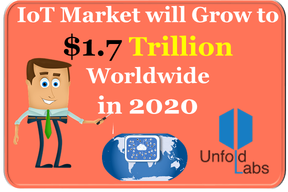
2. IoT
There was a lot of buzz from IoT vendors in 2016 and it's still a promising tech trend especially because it can be applied to almost any industry. It has been used in infrastructure and energy management, manufacturing, agriculture, transportation, advertising, and in the medical field. IoT devices have been used for emergency notification and warning systems; air, water and soil sensors; health monitoring devices, and in consumer devices such as connected cars and wearable tech.
The importance of IoT, however, differs by industry, with IoT believed to be critical in the biotechnology and telecommunications industries but not important to state and local governments. Even if some industries do not see the its importance, Gartner, Inc. predicts that there will be nearly 20.8 billion IoT devices by 2020 and IoT services will focus on new services by end-users and vendors. Moreover, the International Data Corporation projects that the IoT market, primarily devices, connectivity, and IT services, will grow to $1.7 trillion worldwide in 2020.
The negative side to IoT is that fragmentation and cost factors are driving lower consumer adoption. Although regulation and standardization will continue to evolve, fragmentation, or having a single, open, secure and interoperable framework for all IoT products and services, is yet to be seen. Aside from the cost of creating an IoT solution, other concerns, especially for IoT startups, include security, privacy, and a lack of standards.

3. Cryptocurrency
An emerging technology, cryptocurrency saw its share of winners and losers. The top three gainers in 2016 are Bitcoin, which remains at the top of cryptocurrencies, followed by Ethereum, and Ripple. Other cryptocurrencies that also did well in 2016 are Litecoin, Monero, Ethereum Classic, and Dash.
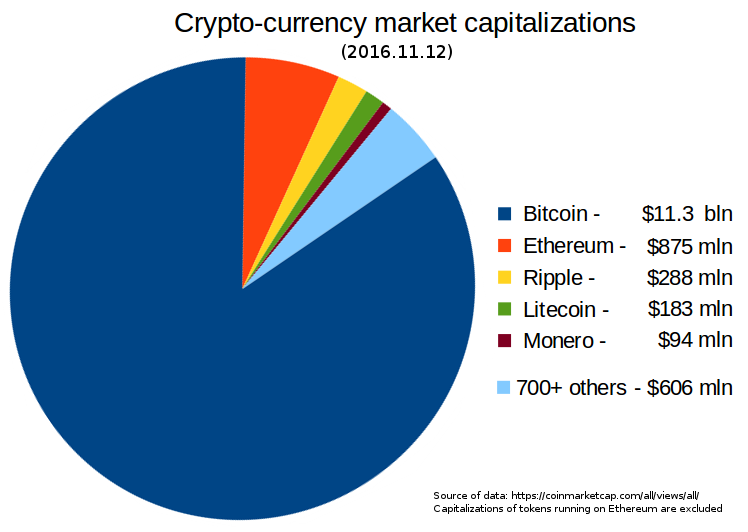
Those that didn't fair too well are Dogecoin, Paycoin, and Ethereum's DAO.
Profit making in cryptocurrency is made through the creation of coins. To date, there are 700 digital currencies. Rather than investing in cryptocurrency per say, investing in the infrastructure, such as companies that process bitcoin payments may be a better way to make money.

4. Digital Medicine
Perhaps the most exciting occurrence in digital medicine, and the first of its kind, is the Proteus ingestible sensor. This FDA-approved technology, that is the size of a grain of sand, is able to digitally record and share information with healthcare providers. For use in conjunction with existing medicines, the sensor, which can monitor heart rate, activity, and rest, provides insight into health patterns and the effectiveness of medications. A small wearable sensor patch that sends information to a patient's smartphone allows doctors to access the data. The data also allows healthcare providers to accurately prescribe drugs as well as measure the effectiveness of treatments.
Digital medicine also aims at transitioning old equipment like pagers and fax machines used in the health care field into more mainstream technology, like wireless technologies, tablets and mobile phones. This means that health care will become not only more efficient, but also more cost effective.
Digital medicine will improve the way patients are monitored and how patients and doctors communicate. Of course apps that track health like Apple's Health or Epic's MyChart already exist, but patients with serious medical conditions will be able to use apps that allow them to download blood pressure levels to their smartphone, for example, and share the data with their doctor.
Glooko, which allows diabetes patients to share their blood-glucose readings with doctors via a smartphone app, shared its predictions for mobile health in 2017 and they include:
- The growth of mobile health systems wherein patients will be using apps for prescription refills, sharing data and getting doctors' advice
- The ability for apps to not only track data, but give insights and recommendations based on that data
- More players in the field of mobile health
Other exciting developments in digital medicine include clinical studies form the Scripps Translational Science Institute that includes a wearable sensor to identify people with asymptomatic atrial fibrillation (AFib), and a wearable pain relief technology on opioid use and pain in cancer patients.
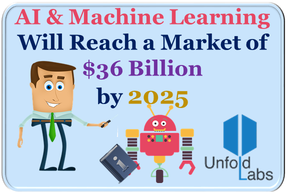
5. AI/Data Science/Machine Learning
AI startups were acquired by major companies in 2016, with the top three acquirers being Google, Twitter and Apple. Of the over 100 private AI companies, 40 acquisitions took place in 2016 — with 11 acquired by Google. In 2011, only five M&A's took place. Other major AI acquirers since 2011 are eBay, IBM, Facebook, Intel, Microsoft, NICE, Yahoo, AOL, Nokia, Twitter, Google DeepMind, Salesforce, GE, Oracle, and Amazon.
The company that looks to have come out on top of the AI game is Nvidia. Nvidia's hardware, is used by nearly all major tech companies, including image recognition for tagging photos in Facebook and the intelligence behind the autopilot feature in all of Tesla's cars. Microsoft has partnered with Nvidia, whose stock rose to over 220% in 2016, to work with their DGX-1 supercomputer. This AI-tailored supercomputer by Nvidia performs the equivalent of 250 conventional servers.
A lot of exciting use cases in Artificial Intelligence are already taking place in finance, telecom, healthcare, and retail. In finance, for example, AI use cases consist of predicting the stock market and quickly execute trades. AI use cases in healthcare include predicting avoidable hospitalizations or spotting cancer before being diagnosed.
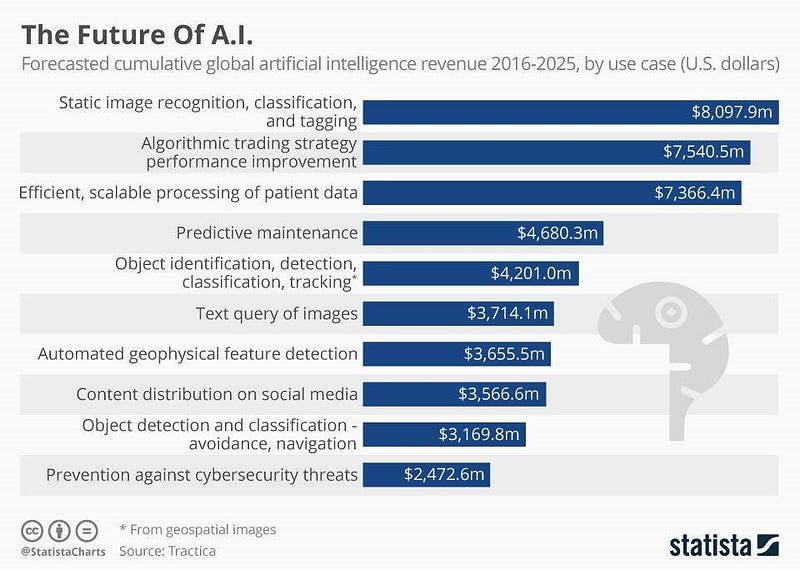
The later part of 2016 saw a lot of activities in AI. One example is Cornell University's robotic hands that are able to sense shape and texture. Estimated to cost $50 to make, the hands may be used to improved prosthetics or used in warehouses and food handling. Another is the new system powering Google Translate, Google Neural Machine Translation. GNMT can reduce translation errors by an average of 60% and has transformed Google Translate by translating a sentence in one language and translating that same sentence in another language.
Data science and machine learning, which uses algorithms capable of making predictions from data, are already being used, such as when you receive friend suggestions on Facebook. The future of data science and machine learning includes the capability of automating many complex tasks related to analytics, like testing a web-based user interface. This branch of AI has been used in the industries of health, retail and finance. A study by the McKinsey Global Institute analyzed that machine learning's greatest potential impact includes improving forecasting and predictive analytics.

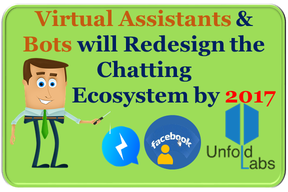
6. Conversational Systems/Virtual Assistants/Bots
Apple started it all with Siri, but soon after voice-activated systems that allow you to do much more than make calls emerged, enabling the creation of a shopping list, and setting reminders. Amazon led the way in personal assistant devices with Echo followed by Google Home. These devices are able to perform multiple tasks like play music, answer questions, provide traffic and weather information, and even control lights and thermostats. As more features are being added, the newer versions will become even smarter.
Facebook started the bot revolution with Messenger, which will soon have its own built-in personal assistant called Facebook M. Powered by both people and AI, Facebook M will be able to assist with a wide range of tasks like recommending restaurants or comparing airline fares. An article in Forbes states that by the end of 2017 there will be as many people on Messenger as Facebook, which has 1.674 billion users, and that's a whole lot of customers to build relationships with.
There is definitely money to be made, especially since it has been estimated, according to Consumer Intelligence Research Partners, that over 3 million Amazon Echos were sold in 2016 doubling its sales from 2015.
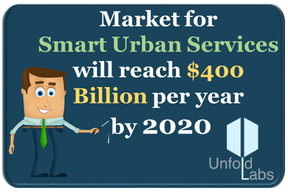
7. Smart Cities
The use of urban informatics aims to create cities that function more efficiently. Smart City technology has been developed by everyone from governments to healthcare and transportation sectors. Today, programs for smart city technologies, such as a traffic management system to keep traffic moving efficiently or sensors able to warn of high levels of pollution, have been implemented in cities all over the world. Amsterdam, Barcelona, Madrid, Nairobi, Dubai, Moscow, and Stockholm are just some cities working to create smart cities. In 2016, of over 40 candidates, New York City was awarded the World Smart City Award by the Smart City Expo World Congress.
The Arup Group estimates the market for smart urban services will reach $400 billion per year globally by 2020. The National Science Foundation planned to invest $60 million in Smart Cities-related grants in 2016, with additional investments planned for connected communities, advanced networking technology, and smart buildings and sensor networks in 2017.
Smart cities will benefit everyone with real-time responses from problems that urban communities face. In the future, cities will become more interconnected, thereby helping to improve how a city functions to make better use of resources. With a global urban population that is projected to grow nearly 2% each year until 2020, according to the World Health Organization, smart cities will help to meet demands of increasing challenges that are tied to a growing population.
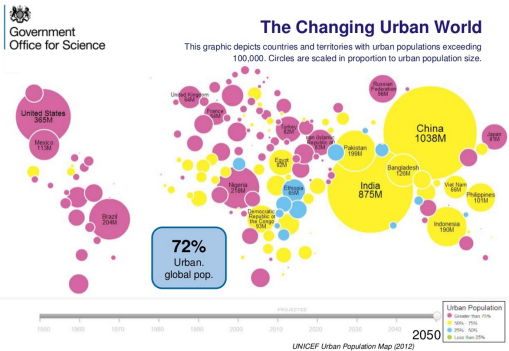
Our Take
With all the emerging trends, 2017 will certainly be a year worth looking forward to — at least in the world of tech.
Drivers are ready to pay a premium for connected cars and fully autonomous vehicles so the race is definitely on as to who will be the first to perfect the technology. Although there aren't as many players in the flying car market, that could change if there is much success with the current prototypes.
IoT needs to gain a little more momentum, not just in consolidation, but also with how investors can make money using the technology, which will probably be in IoT services rather than devices.
Although everyone hasn't embraced cryptocurrency, this form of alternative currency does have numerous benefits, like not being able to be counterfeited, so it's not going away in 2017.
Many promising and exciting technologies are yet to be seen in digital medicine, but regulatory approvals and accuracy and reliability are still major concerns.
AI will continue to be ubiquitous and use cases will continue to help make concepts a reality. Voice activated and virtual assistants are here to stay — only to improve as time goes by — allowing us to get even more information instantly.
Certainly we have just seen the tip of the iceberg with smart cities, which will profoundly help with the challenges of urbanization. In addition to improving quality of life, smart cities will help improve the environment.
If there are any uncertainties, one thing is for sure — there will be much more room for growth for these top 7 trends in 2017.